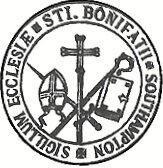Boniface - our patron saint
Boniface [“Maker of Good”] is our patron’s name in religion; his given name was Wynfrith [“Friend of Peace”], and he was born allegedly to a Saxon father and a native British mother in about 675 at Crediton near Exeter in Devon. He was educated in Exeter before entering the monastery at Nursling, here in Southampton.
When aged 30 he was ordained a priest, but some ten years later he threw up the prospect of a peaceful life teaching and preaching in this country in order to be a missionary. He first followed his fellow Englishman, the Yorkshireman St. Willibrord, to Frisia, the bleak coastal region between Amsterdam and Hamburg, but the mission there was unsustainable, and he returned to Nursling where he was elected Abbot but refused to accept. In 718 Pope Gregory II gave him a definite mission further south in Germany, in the land of Hesse, around Frankfurt, and further east in Thuringia. He was consecrated bishop in 722.
During this mission there occurred the famous episode when he cut down the pagans’ Oak Tree of Thor at Geismar near Kassel; the failure of Thor, god of Thunder, to intervene caused large numbers to turn to Christ. [Allegedly this is the origin of the Christmas tree]. Boniface made much use of monastic foundations to spread the faith and was made an archbishop in 732, technically at Mainz on the Rhine, though in fact he remained a travelling missionary. He also appealed to the English to help the conversion of “those who are of one blood and bone with you”.
Boniface laboured hard to educate half-converted Christians who were hampering rather than helping the mission, was responsible for healthy Church reform, particularly in France, and ensured that the Rule of St. Benedict, which proved such an anchor of stability in the hard times of the Dark Ages, was the principle of monastic life. At Soissons in France in 751 he crowned Pepin “King of all the Franks”, the precursor of the great Holy Roman Empire which came into being with Pepin’s son Charlemagne in the year 800.
At the age of nearly 80 he left his diocese in Mainz in the hands of another, and set off back north to Frisia to end his days as a simple missioner in the region where he had first begun. It was here in 754 at Dokkum, near the North Sea coast in what is now part of the Netherlands, that he was attacked by a band of pagans as he waited to confirm a group of new converts, and was killed along with his companions. The saint tried to defend himself from a blow to the head with a holy book, allegedly “The Advantage of Death” by St. Ambrose.
His body was taken to Utrecht, then to Mainz, and is now enshrined in the Cathedral at Fulda, N.E. of Frankfurt, which was the site of one of his most prosperous monasteries; he is the patron of the German and Dutch people. It has been said that “he had a deeper influence on the history of Europe than any other Englishman”, principally by virtue of his initiating the relationship between the Papacy and the Emperor, on whom the progress and consolidation of medieval Europe chiefly depended.

